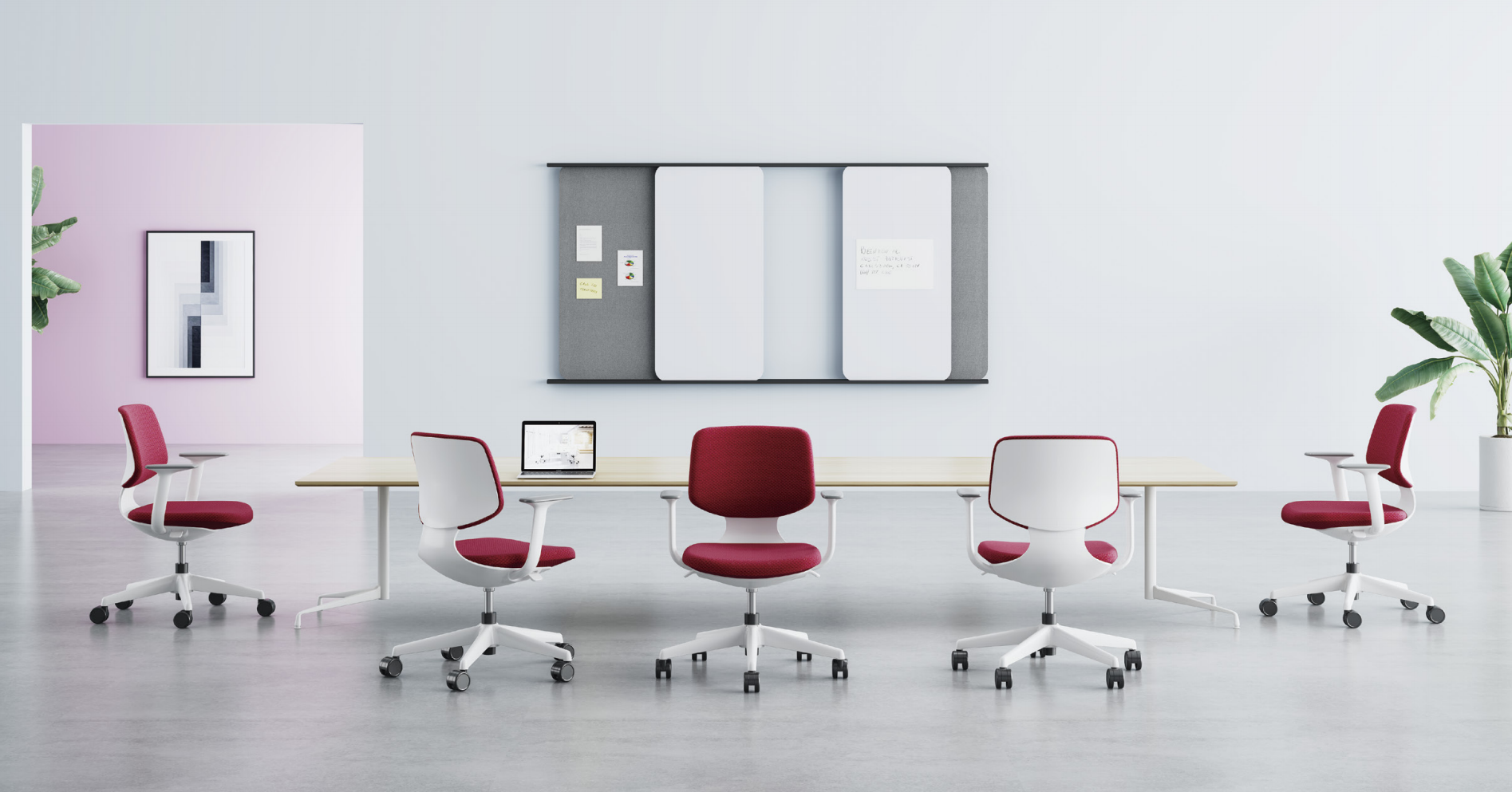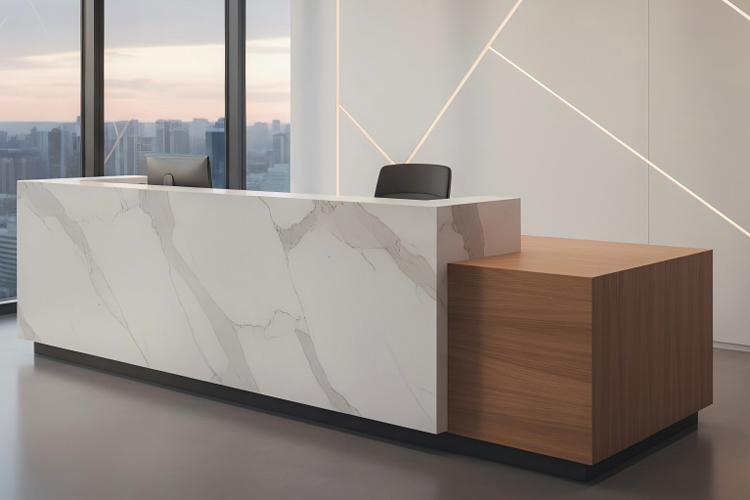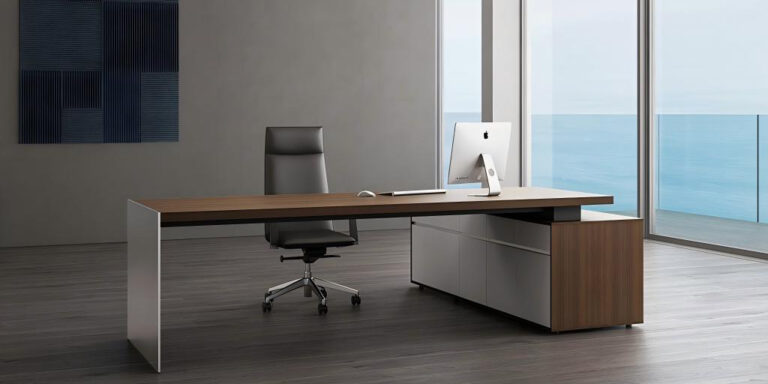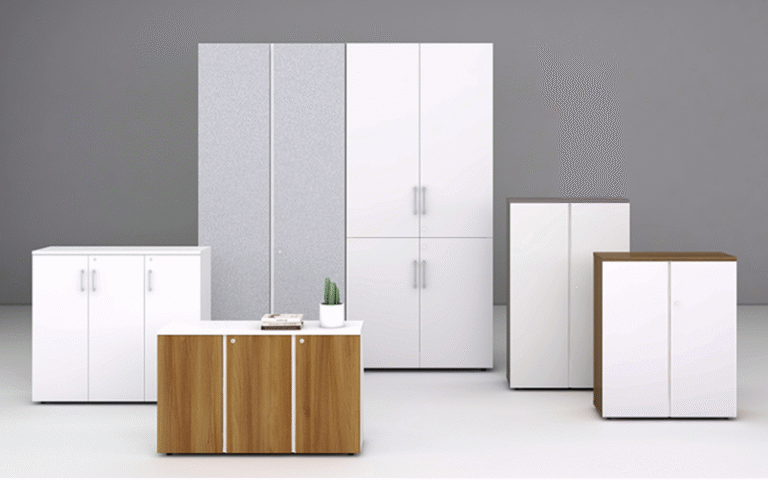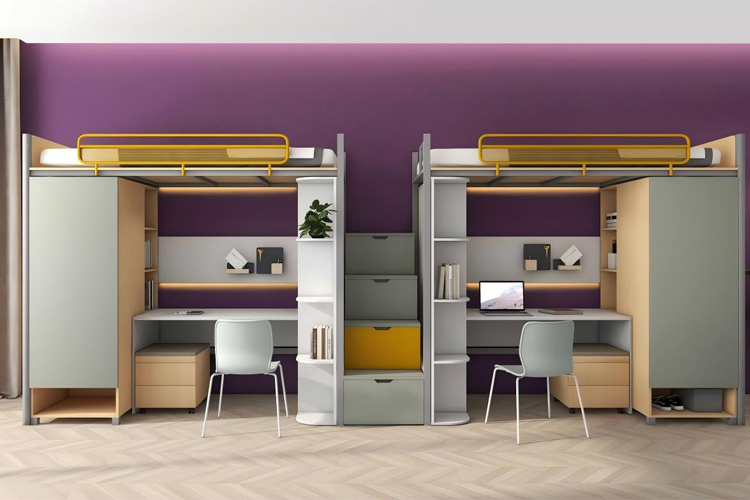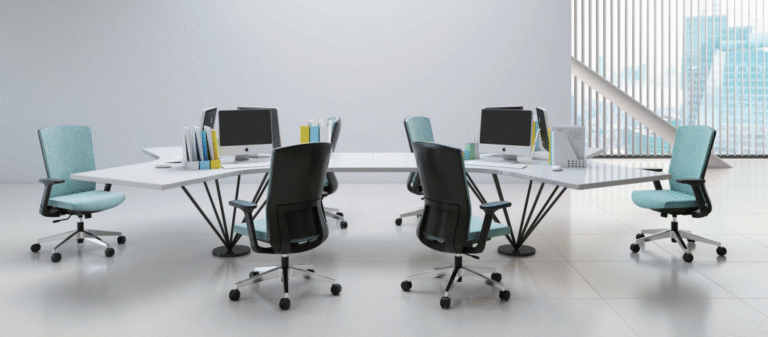How to Choose Conference Room Chairs: The Definitive Guide
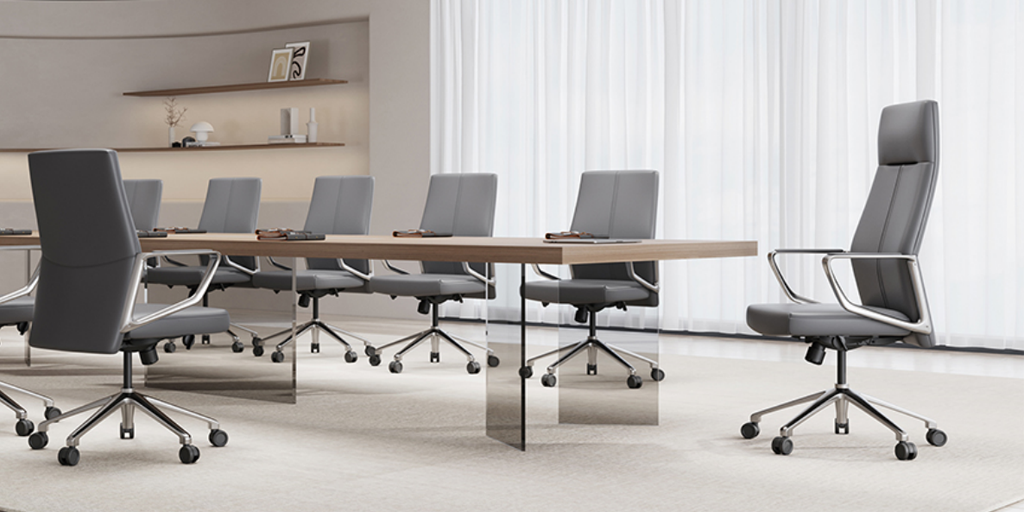
Have you noticed your back aching in meetings? Watching the clock because your back hurts each time. Well, you’re not the only one. Studies indicate that 74% of employees dealing with uncomfortable office chairs are experiencing pain. This, in turn, makes it increasingly challenging to concentrate or complete tasks. The office chairs your company provides may be crippling your employees’ creativity.
The problem is easy to see: Many offices pick chairs only by price or style. They don’t think about sitting in them for an hour or more. People end up moving around, losing focus, or feeling tired.
The fix? Choosing the right conference room chairs. Good chairs support your team’s bodies and minds. This isn’t about fancy seats. It’s about helping people focus, stay longer, and do better work.
Let’s discuss the simple steps to pick chairs that fit your space, budget, and team.
Assessing Conference Room Size and Capacity
Your conference room size decides how many chairs fit. Too many chairs feel crowded. Too few waste space. Measure first. Plan second.
Measuring Your Conference Room Dimensions
Know your room shape. Rectangular rooms need long tables. Place chairs along the longer sides. Leave 30 inches behind chairs for walking. Square rooms work with round tables. Use a U-shape layout if square. This helps everyone see the speaker. Always measure wall to wall. Note doors and windows. Doors need space to open. Windows might block wall space. Write down your room’s length and width.
Calculating Maximum Seating Capacity
Follow this simple guideline. Allow 10-12 sq ft per person to include space for chairs and movement. Start with your room’s total square feet and subtract space for cabinets or screens. For instance, a 10ft x 12ft room equals 120 sqft. Now subtract 20 sqft for a screen. You have 100 sqft. Divide by 10 gives you 10 chairs maximum.
In spaces under 100 sq ft, chairs fitting in small rooms would fit 4 to 6 chairs. A 10ft x 10ft room has 100 sq ft and safely fits 6 chairs. In larger rooms over 200 sq ft can comfortably accommodate 15 or more chairs. An example is a 15ft x 20ft room which has 300 sq ft and fits 25 chairs. Always check walkability behind the chairs after testing all pushed back from the table.
Meeting Time Matters: Pick Chairs That Last
After fitting chairs to your room space, consider how long people actually sit. Meeting duration shapes chair comfort needs dramatically. Short meetings need less support while long sessions demand serious attention to detail.
Short Meetings Under 1 Hour: Keep It Simple
Quick meetings like daily check-ins or brief team chats require simple chairs. Since people sit for 30 minutes or less, basic ergonomic features work perfectly fine. Thin padding feels adequate for these short sessions, and fixed-height chairs won’t cause issues. Armrests become optional extras because attendees frequently stand up during discussions. Breathable fabric adds comfort but isn’t essential here. This approach saves money for investing in critical long-meeting chairs.
Extended Sessions Over 2 Hours: Comfort Is Non-Negotiable
Chairs used for lengthy meetings take on even greater challenges during strategy sessions or workshops. Discomfort becomes evident if there is inadequate support when sitting for prolonged periods. Backs begin to hurt after 45 minutes, and adjusting seating to provide relief becomes a group distraction. In order to soften soreness, conference room chairs should have additional cushioning, for instance 2-inches or more thick padding. Strong lumbar support maintains proper posture while breathable mesh or perforated leather backs cool down heat build up. Relaxed shoulders are provided by flexible armrests designed for various body shapes. Ignoring these features invites great restlessness which reduces performance.
Style and Design: Choose Chairs That Fit Your Office
After considering room size and meeting length, think about looks. Style and design matter for your office vibe. Chairs should match your space and brand.
Matching Chairs to Modern vs. Traditional Spaces
Modern offices need sleek, simple chairs. Think mesh backs and metal frames. These fit tech startups or creative studios. Traditional offices look better with leather or wood. Executive suites often use these. The wrong style feels out of place. A modern chair in a classic room looks odd. Match chairs to your office feel.
Color and Material Coordination
Chairs should blend with your room style. Look at your walls and tables. Pick chair colors that complement them. Bright chairs stand out in neutral rooms. Dark chairs fit formal spaces. Materials matter too. Leather feels professional. Fabric feels casual. Match materials to your brand image. A law firm might use black leather. A design agency could pick colorful fabric.
Conference Chair Types: Pick the Right Style for Your Space
After matching chairs to your office style, focus on functionality. Conference chair types serve different needs. Some prioritize movement, others comfort or space-saving.
Mesh Chairs With Or Without Wheels
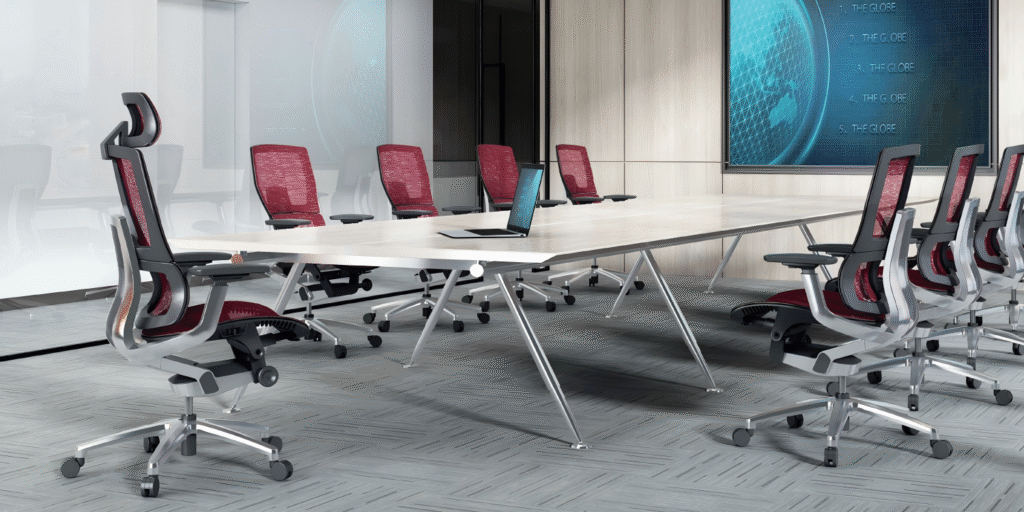
Mesh chairs work well in collaborative spaces. The breathable back keeps users cool during long meetings. Chairs with wheels allow easy movement between discussions. This helps in brainstorming sessions. Stationary mesh chairs offer more stability. They suit spaces where people stay seated longer. Choose wheels for active teams. Pick fixed bases for focused meetings.
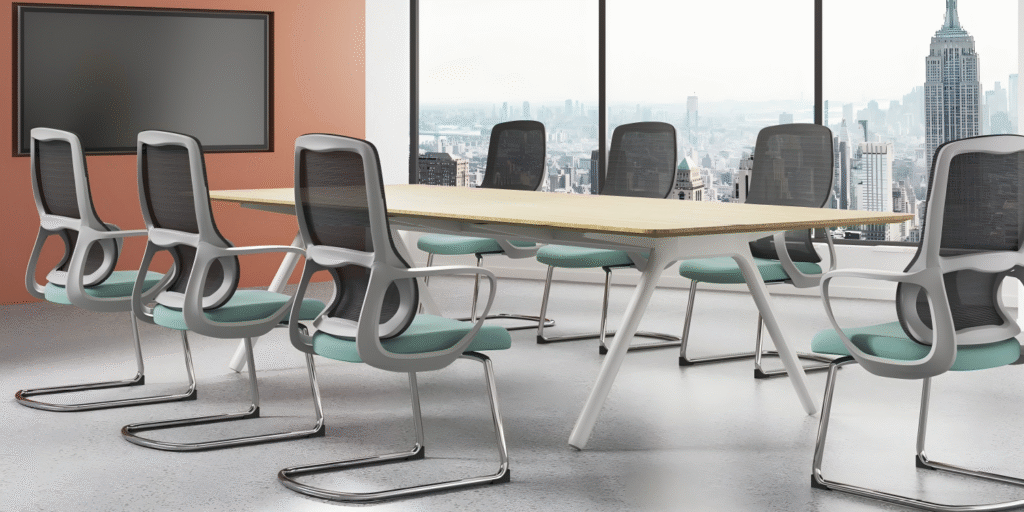
Leather Chairs With Or Without Wheels
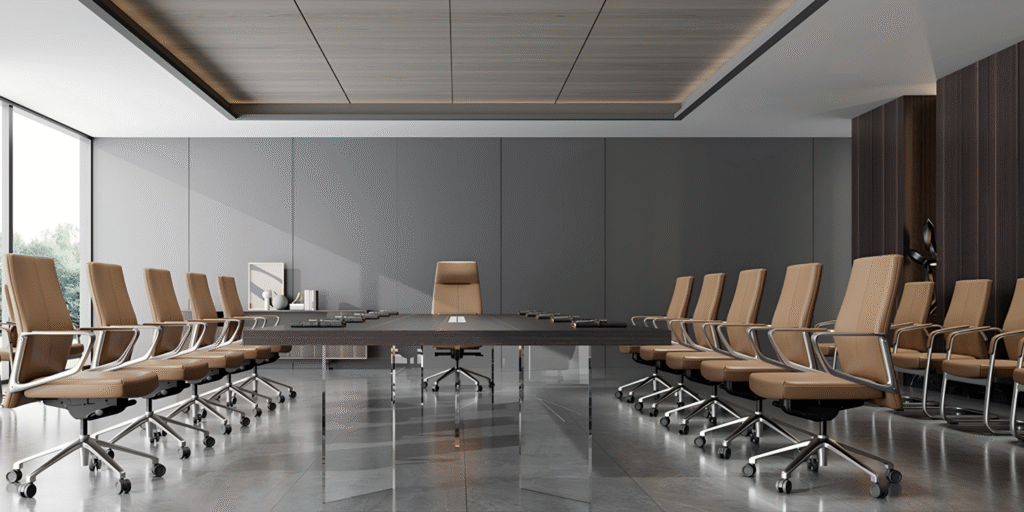
Leather chairs bring a formal look to executive rooms. They feel luxurious and last longer than fabric. Wheels on leather chairs help in large meeting spaces. But fixed bases work better in traditional boardrooms. They prevent unwanted movement during serious talks. Leather needs more care than mesh. It shows wear faster but ages well.
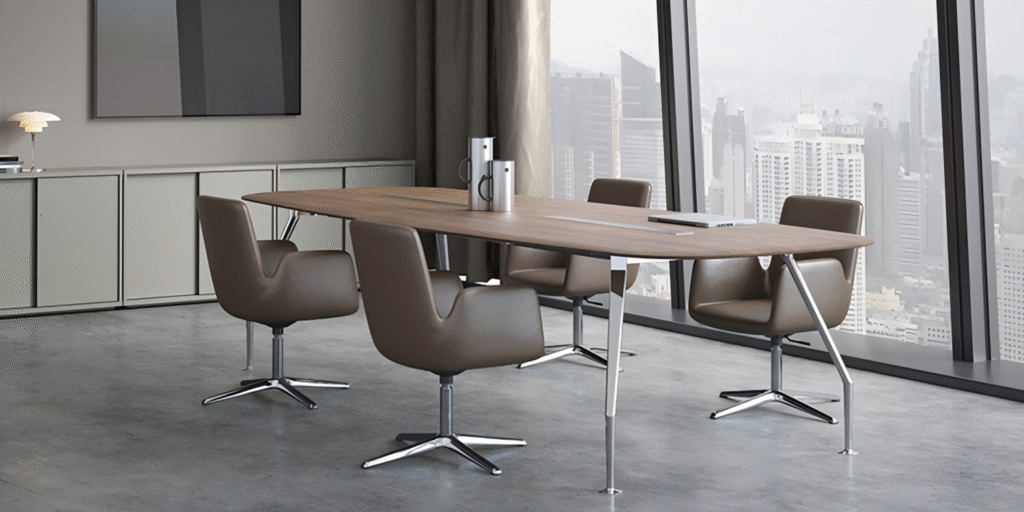
Stackable and Foldable Options
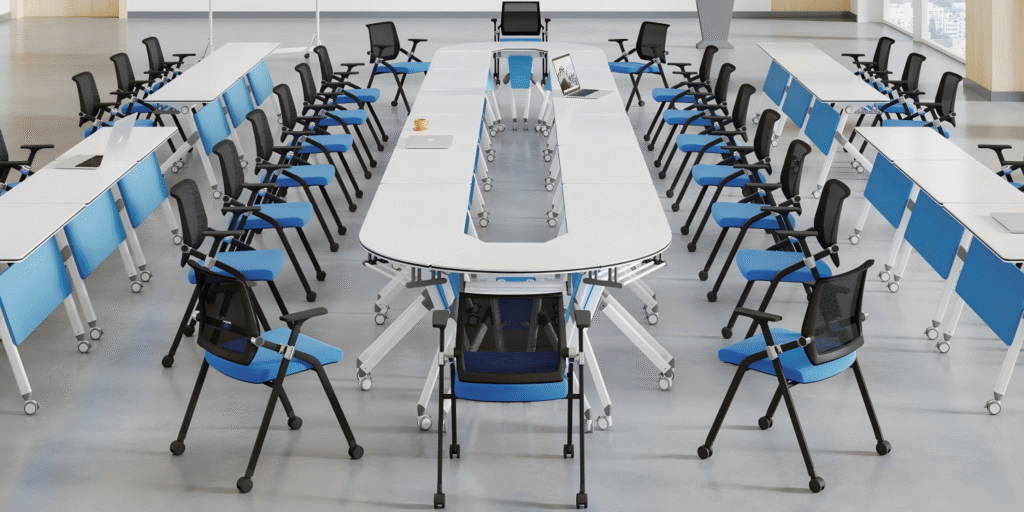
Stackable chairs solve space problems. Training rooms need chairs you can store easily. These work for events with changing attendance. Foldable chairs help even more. You can tuck them away when not needed. Both types sacrifice some comfort for flexibility. They’re not ideal for daily use but perfect for multi-purpose areas.
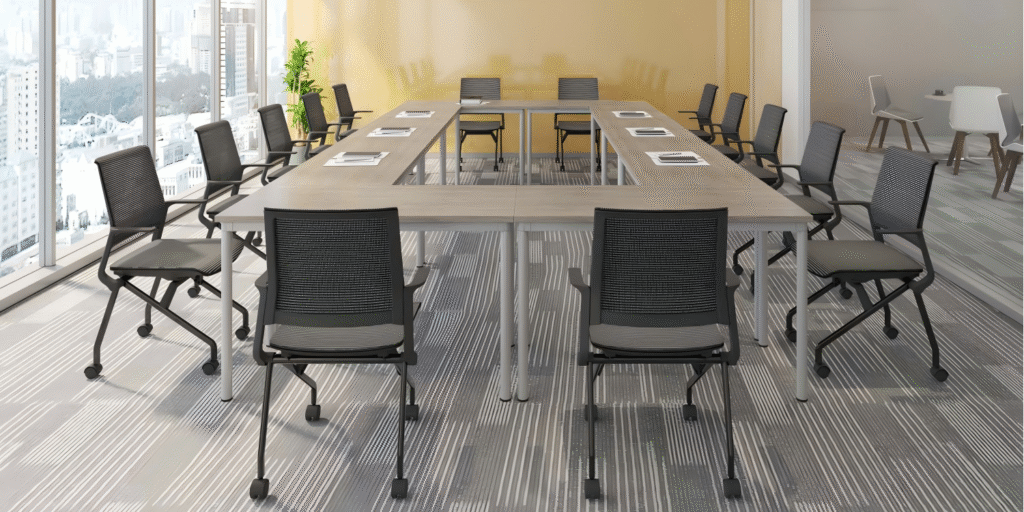
Ergonomics: Comfort That Boosts Productivity
Good conference chairs do more than look nice – they support the body. Ergonomics prevent pain and keep minds focused. Ignore this, and meetings become endurance tests.
Must-Have Ergonomic Features
Four features separate good chairs from great ones. Adjustable height matters most – people’s legs need to sit at 90 degrees. Armrests should move up and down to fit different desks. Proper lumbar support maintains the spine’s natural curve. Without it, backs ache within 30 minutes. Swivel bases help people reach different table spots. These adjustments let one chair fit most body types.
Testing Chairs for All Body Types
Chair testing requires more than sitting briefly. Check seat depth – knees shouldn’t press the edge. The seat should leave 2-3 inches behind your knees. Width matters too – narrow chairs pinch hips. Have multiple staff test chairs before buying. Tall people need higher backs. Short people need adjustable footrests. A chair that fits everyone prevents complaints and injuries.
Functionality: Smart Choices for Your Space
Conference chairs must work with your room’s needs. The right balance keeps people comfortable without wasting space. Poor choices lead to cramped rooms or useless chairs.
Wheels vs. Stationary Bases
Chairs with wheels help in active workspaces. People move easily during brainstorming sessions. The wheels let them reach whiteboards or join groups. But wheels cause problems in formal meetings. Chairs slide when people lean forward. Stationary bases keep chairs in place. They work best for presentations or client meetings. Consider your meeting style before choosing.
Space-Saving Designs for Compact Rooms
Small rooms need smart solutions. Nesting chairs tuck together when not in use. They save floor space while keeping chairs ready. Foldable chairs work better for storage. You can stack them in closets between uses. Both options help multi-purpose rooms. But nesting chairs set up faster for quick meetings. Foldable ones work when storage space is tight. Measure your room before deciding which fits best.
Budget Considerations: Smart Spending for Lasting Quality
Choosing conference chairs involves balancing cost and quality. A smart budget plan gets you durable chairs without overspending. Cheap chairs break faster, costing more long-term.
How Budget Shapes Conference Room Chairs
Your budget determines what features you can get. Limited funds mean prioritizing essentials. More money allows for premium materials and adjustments. Always match chair costs to how often they’re used. Daily-use chairs justify higher spending. Occasional-use chairs can cost less. Plan for replacements too. Good chairs last years, saving money over time.
Cost vs. Value: Material and Durability Trade-offs
Mesh chairs cost less upfront but wear faster. The fabric stretches and stains over time. They work for tight budgets or low-use areas. Leather chairs cost more but last longer. High-quality leather improves with age. It resists stains and tears better than mesh. Mid-range options exist too. Polyurethane leather offers a balance. It looks like real leather but costs less. Consider how long you’ll keep the chairs before choosing materials.
Collaborative Spaces: Seating That Boosts Teamwork
Some meetings need more than standard chairs. Collaborative spaces demand flexible seating that adapts to group work. The right setup keeps teams comfortable and engaged.
Modular Chairs for Dynamic Meetings
Modular chairs solve the problem of changing group sizes. Lightweight designs let teams rearrange seats quickly. Look for chairs under 15 pounds with built-in handles. These work well for design sprints or workshops. Avoid bulky chairs that are hard to move. The best modular options connect together when needed. This creates instant group seating without wasting space.
Encouraging Interaction Through Seating
Round tables with swivel chairs help teamwork. People can face different speakers easily. Swivel bases let team members turn to whiteboards. Avoid chairs with high backs in these spaces. They block sightlines across the table. Low-profile chairs keep everyone visible. Include some mobile chairs for spontaneous huddles. This flexibility encourages natural collaboration.
ONMUSE Furniture: Embracing 2025 Design Innovations
ONMUSE Furniture integrates 2025’s defining trends—sustainable materials, multifunctional design, and Art Deco influences—into collections that balance aesthetics with practicality.
Sustainable Material Selection
ONMUSE prioritizes eco-friendly textiles and ethically sourced wood, mirroring 2025’s emphasis on sustainability. Their use of warm brown tones (Pantone 25’s trend color) and wine red accents creates earthy yet luxurious palettes suited for modern interiors .
Modular & Multifunctional Designs
Aligning with the trend for adaptable spaces, ONMUSE’s modular sofas and nesting tables offer reconfigurable layouts—ideal for compact urban living. This versatility supports the 2025 demand for furniture that maximizes functionality without sacrificing style .
Art Deco & Maximalist Inspirations
Geometric patterns, glossy finishes, and bold statement pieces from ONMUSE channel the revived Art Deco movement. Their maximalist approach combines textures like velvet and brushed metal, embodying 2025’s “more is more” ethos for vibrant, personalized spaces .
Key Trend Alignment Summary:
| 2025 Trend | ONMSUE Implementation |
| Pantone 25 Colors | Earthy browns + wine red accents |
| Multifunctionality | Modular sofas; expandable tables |
| Art Deco Luxury | Geometric forms; metallic finishes |
| Sustainable Craftsmanship | Ethically sourced materials |
ONMUSE’s 2025-focused collections demonstrate how trend-conscious design elevates everyday living—transforming furniture into functional art .
Conclusion: The Right Chairs Transform Your Meetings
There are eight factors to pay attention to when buying conference room chairs. Your room size determines your capacity, so measure the room first. Consider meeting length—longer sessions may require more comfort. Tailor the chairs to your office for a seamless style.
Type of chair selection matters too. They can break down into mesh, leather, or stackable. Ergonomics should not be compromised; adjustable features minimize pain. Function and space can be balanced with wheels or compact designs. Long-term value should shape the budget set. Lastly, collaborative spaces should have interactive modular seating.
Long-term investment in the right chairs elevates your workspace. Good seating improves focus and comfort. Productivity increases alongside enhanced comfort. Teams perform at their best without discomfort distractions.
Always to sit test before purchase. Have employees sit for 30 minutes to evaluate support and comfort, adjusting if necessary. Smooth function of all adjustments helps identify a perfect chair. Enhanced meeting engagement and team performance follows.

